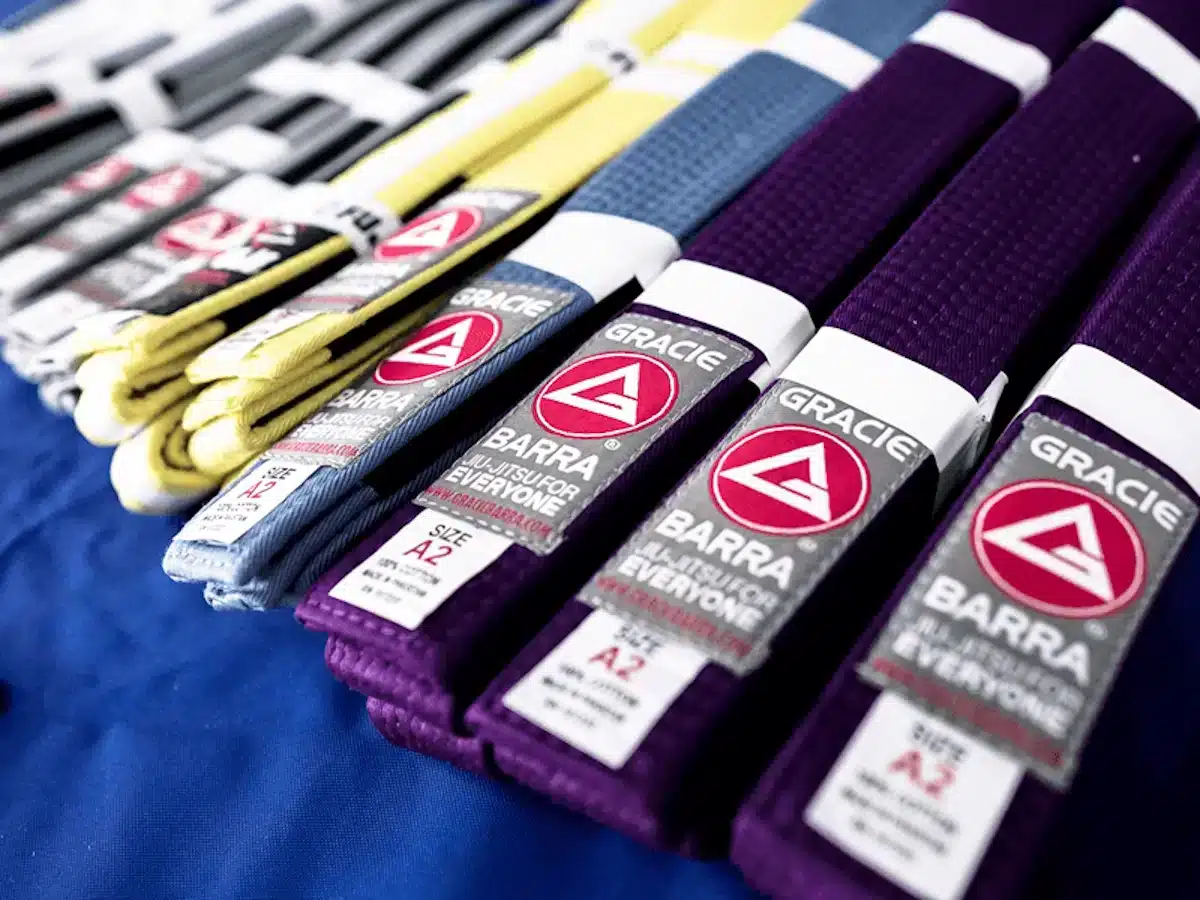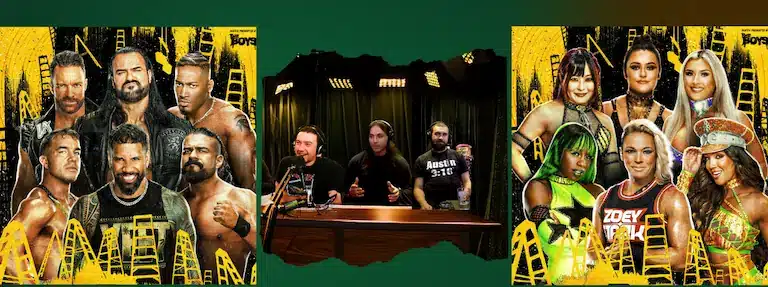Brazilian Jiu-Jitsu is often likened to a game of chess, with each belt representing a new level of knowledge and skill. As practitioners progress through the ranks, they gain access to more advanced techniques and strategies – just like the chess pieces on a chessboard.
This article will explore the Brazilian Jiu-Jitsu Belt Ranking system, detailing each rank’s progression requirements, essential techniques, and responsibilities.
Furthermore, it will discuss the rules and regulations surrounding belt integrity and competition.

Key Takeaways
- The Brazilian Jiu-Jitsu belt system is unique, and primary promotion ceremonies mark progression.
- There are different belt colours for children between the white and blue ranks.
- Each belt can have up to four stripes awarded to mark progress.
- A brown belt signifies a high skill level and experience before reaching the black belt level.
Understanding the Belts
There are seven belts in total in the BJJ jiu-jitsu, each with its distinct requirements and responsibilities, thus the Brazilian Jiu-Jitsu Belt Ranking.
White belts signify the beginning of the journey, focusing on learning the basics and developing the mindset of a successful practitioner.
Blue belts are ready to learn more advanced techniques, while purple belts are transitioning from beginner to expert.
Brown belts are experienced practitioners and have begun the journey to black belt.
Black belts are recognized as jiu-jitsu professors, with the highest level of mastery being the coral belt.
Children have their belt progression between white and blue.
Stripes can be awarded at each belt level up to four times to mark progress.
Regular attendance and progress in knowledge can earn stripes, with average time at each belt level ranging from 2-5 years.
It is essential to understand the belt system and the responsibilities of each belt to progress in Brazilian Jiu-Jitsu.
Brazilian Jiu-Jitsu Belt Ranking Progression Requirements
Progression requirements are key to moving up the Brazilian Jiu-Jitsu belt system ranks, with specific criteria for each belt that must be met.
For example, a white belt should focus on learning basic positions, mastering guard passing, and working on conditioning.
Blue belt requires the practitioner to be able to defend against standard submissions and explore more advanced techniques.
As a purple belt, they should focus on developing a dangerous guard game and executing combination attacks.
For a brown belt, they should have a nearly flawless grasp of the basics and possess a well-rounded knowledge of advanced techniques.
Finally, a black belt should demonstrate wisdom and discipline in teaching jiu-jitsu and leading a beginner-level class independently.
It’s important to note that the duration of each belt level can vary significantly, and the number of stripes awarded on each belt depends on the student’s progress.
With this in mind, it is crucial to understand the fundamental techniques that will help you progress through the belt system.
Key Techniques
In Brazilian Jiu-Jitsu, progression through belt levels requires mastering numbered techniques. White belts focus on building a solid foundation of basics and improving their fitness. Blue belts can defend against standard submissions and explore more advanced techniques. Purple belts are expected to develop a dangerous guard game and execute combination attacks with precision.
In jiu-jitsu, brown belts work on honing their skills and preparing for the journey toward the coveted black belt. They also demonstrate wisdom and discipline while teaching the martial art. Black belts are leaders in the jiu-jitsu community, leading academies and seminars and earning respect and recognition. Finally, coral belts represent mastery of the sport and come with the responsibility of giving back to the jiu-jitsu community.
To progress in belt ranks, it is vital to have a deep understanding of the basics and advanced techniques. This includes having a well-rounded knowledge of various training strategies. Once a practitioner has mastered these fundamentals, they can develop their style, taking into account their strengths and weaknesses. Additionally, it is crucial to continue learning about different training techniques to continue improving and advancing.
Training Strategies
Understanding multiple training strategies for progression through the Brazilian Jiu-Jitsu Belt Ranking system is important. Consistency in attendance, advancement in knowledge, and practice are essential for earning stripes.
For beginner white belt students, it’s important to focus on learning the fundamentals, improving overall fitness, and gaining a strong understanding of basic concepts. As a blue belt, the focus should shift towards defence, mastering guard passing techniques, and having multiple escape strategies. Purple belts should strive to develop a dangerous guard game and execute combination attacks. For brown belts, it’s all about refining skills and preparing for the journey toward the coveted black belt.
As a brown belt, it is crucial to have a near-flawless understanding of the basics, a well-rounded knowledge of advanced techniques, and the ability to create variations and sequences independently. Additionally, it is essential to develop your own style, identify your strengths and weaknesses, and create complex and compelling game plans. At this stage, brown belts can assist in teaching lower-level students, run classes, and demonstrate wisdom and discipline in teaching jiu-jitsu.
Earning a black belt in jiu-jitsu indicates a high level of proficiency and experience. Black belts are considered experts and leaders in the jiu-jitsu community, managing academies and workshops, arranging and taking part in competitions, and earning respect and recognition. Red/coral belts indicate the level closest to mastering jiu-jitsu and come with the responsibility of giving back to the jiu-jitsu community.
Training strategies should focus on consistency, understanding concepts, mastering techniques, and refining skills. Through dedication and hard work, practitioners of Brazilian Jiu-jitsu can strive to reach the highest level of mastery.
History of BJJ
Although training strategies play an important role in progressing through the BJJ belt system, the history of Brazilian Jiu-jitsu is equally significant in understanding its current structure.
BJJ is a martial art that originated in Brazil in the early 20th century and was popularized by the Gracie family. It was designed to allow a smaller person to defend themselves against a larger opponent.
The belt system was adapted from judo and other martial arts and is unique in that it allows progress to be tracked through stripes on each belt. There are five main belts: white, blue, purple, brown, and black. Children have their belt colours added between white and blue.
Each belt has its own set of skills, responsibilities, and goals. For example, a purple belt is the transitional period from beginner to expert. As practitioners progress through each belt, they gain more profound knowledge of the techniques and can further refine their skills.
Each belt has its own set of skills, responsibilities, and goals. For example, a purple belt is the transitional period from beginner to expert. As practitioners progress through each belt, they gain more profound knowledge of the techniques and can further refine their skills.
The black belt is seen as the ultimate goal of most jiu-jitsu practitioners and signifies a high level of skill and experience.
Ultimately, the history of Brazilian Jiu-jitsu is crucial to understanding the belt system and the progression of students from white belt to black belt.
Key Takeaways
By understanding the history of Brazilian Jiu-jitsu and the various belt colours and their associated skills, responsibilities, and goals, practitioners can gain a deeper appreciation for the belt system and the progress they can make.
White to black belts focus on mastering fundamentals, developing defence, and executing combination attacks, while brown belt practitioners specialize in specific areas or experiment with modifications.
Red/coral belts signify mastery and require a lifetime dedication to the sport, with responsibilities such as teaching others, leading classes, and organizing tournaments.
The belt system is slightly different for children, with five levels per belt and stripes awarded for knowledge, behaviour, and tournament performance.
Ultimately, the belt system is a marker of skill, experience, and a journey of self-discovery that is both challenging and rewarding.
System Foundations
Brazilian Jiu-jitsu belt rankings frequently represent skill, experience, and a journey of self-discovery. The belt system is unique to BJJ and provides an effective way to progress in the martial art. Generally, the system consists of six belts, from white to red/coral. The average time to go from one belt to the next varies but typically takes two to five years.
Martial arts have different levels that require practitioners to master specific techniques. For example, at the white belt level, practitioners must learn techniques such as guard passing and armbar series. They must possess the skill of combination attacks at the purple belt level. They are expected to learn more advanced techniques and refine their skills as they progress through different levels. Practitioners can enhance their style and improve their skills. The brown belt is considered a significant milestone before reaching the highest level of black belt.
Finally, black belts and red/coral belts come with the responsibility of giving back to the community. This includes teaching lower-level students, running classes, and demonstrating wisdom and discipline. The SJJIF imposes Belt Integrity rules to ensure the belt rankings’ accuracy and prevent sandbagging. With this, the Brazilian Jiu-jitsu belt system serves as an effective way to progress in martial arts.
In the next section, we will discuss prominent BJJ practitioners.
Prominent BJJ Practitioners
In the Brazilian Jiu-jitsu community, there are several renowned practitioners who have made significant contributions to the sport over the years. Most of them have achieved the level of black belt, won world championships, and are highly respected in the competitive jiu-jitsu world. These individuals have constantly pushed the boundaries of the sport, taking it to new heights.
Renzo Gracie is widely recognized as an iconic figure in Brazilian Jiu-Jitsu. He is a 9th-degree red belt and holds a black belt in Judo. Renzo is acknowledged as one of the original practitioners of Brazilian Jiu-Jitsu and is credited with expanding Gracie Jiu-Jitsu, which has today become the foundation of the sport.
Marcelo Garcia is a 5-time World Champion and has been called one of the best pound-for-pound grapplers in the world. He has been credited with inventing the “X-Guard” and is known for his innovative and creative style. He has also been an enormous influence in the world of competitive jiu-jitsu.
Rickson Gracie is regarded as one of the most outstanding jiu-jitsu practitioners ever, holding a 9th-degree red belt. He is known for his exceptional submission grappling and unique blend of judo and wrestling techniques. Rickson has never been submitted and is considered to have the most complete style of any practitioner.
In the UFC, there are several outstanding Brazilian Jiu-Jitsu fighters who have achieved great success. Each of these fighters has utilized their BJJ background uniquely to succeed in the Octagon by exercising their grappling skills to control, submit and dominate their opponents.
Charles Oliveira is a highly accomplished fighter in the UFC, renowned for his exceptional Brazilian Jiu-Jitsu skills. He currently holds the record for the most submission wins in UFC history. Oliveira’s grappling techniques are formidable, and he is particularly skilled in executing the guillotine and rear-naked choke holds, which he has used successfully against top contenders such as Dustin Poirier and Justin Gaethje.

Gilbert Burns, a four-time world champion in Jiu-Jitsu, has effectively implemented his grappling expertise into his MMA strategy. His mastery of Brazilian Jiu-Jitsu has played a crucial role in his successes, empowering him to win fights and secure victories against renowned adversaries such as Demian Maia and Stephen Thompson.
Aljamain Sterling is one of the top BJJ artists in the UFC bantamweight division. His grappling skills have been a cornerstone of his fighting style, which has helped him become one of the best all-around fighters in the division.
Rodolfo Vieira has an impressive grappling resume, boasting five IBJJF World Championships and an ADCC Championship. Despite facing challenges in adapting to MMA, his BJJ expertise remains a formidable aspect of his fighting style.

A rising star in the UFC featherweight division, Ilia Topuria has showcased high-level grappling skills. His BJJ has been instrumental in his undefeated streak, with a notable victory coming from an arm-triangle choke against Bryce Mitchell.
Brazilian jiu-jitsu owes a lot to a select group of influential practitioners who have been instrumental in pushing the boundaries of the sport and shaping it into what it is today. These individuals have served as a source of inspiration for countless practitioners, motivating them to strive for excellence in this martial art and aim for greatness.
Frequently Asked Questions
What Is the Average Age for Promotion Between Belts?
Depending on attendance, progress, and mastery, promotions are awarded after a minimum time. Age requirements and promotion timelines differ by belt level.
How Do I Know When I Am Ready to Be Promoted?
It’s important to be dedicated, attend consistently and practice regularly to progress to the next level. Additionally, competing at a higher belt level can offer many benefits and be a rewarding experience.
Are There Any Benefits to Competing at a Higher Belt Level?
Competing at a higher belt level can be a rewarding experience, allowing you to challenge yourself against more experienced opponents and test your skills in new ways. The rewards can be great, but make sure you’re ready for the challenge.
Are There Different Rules for Children’s and Adult Belt Systems?
Yes, there are different rules for children’s and adult belt systems. Children’s belts have five levels; stripes are awarded for time, knowledge, behaviour, and tournament performance. Adults have five belts, and instructors determine promotion times, while black belts require affiliation with SJJIF and have seven levels.
What Are the Requirements for Earning a Black Belt?
To earn a prestigious black belt in martial arts, one must dedicate years of practice, master advanced techniques, demonstrate wisdom and discipline, and become an experienced leader and teacher.
Conclusion
Brazilian Jiu-jitsu is a complex art with an intricate belt ranking system. With each belt comes a set of techniques, strategies, and responsibilities, and practitioners must progress through the ranks to gain access to more advanced knowledge.
Ultimately, the system of belts provides a pathway to understanding the art and the history of the sport while also allowing practitioners to challenge themselves and strive for excellence.
Through training and dedication, practitioners can experience the unparalleled sense of accomplishment and personal growth that comes with mastering the art of Jiu-Jitsu.

























